

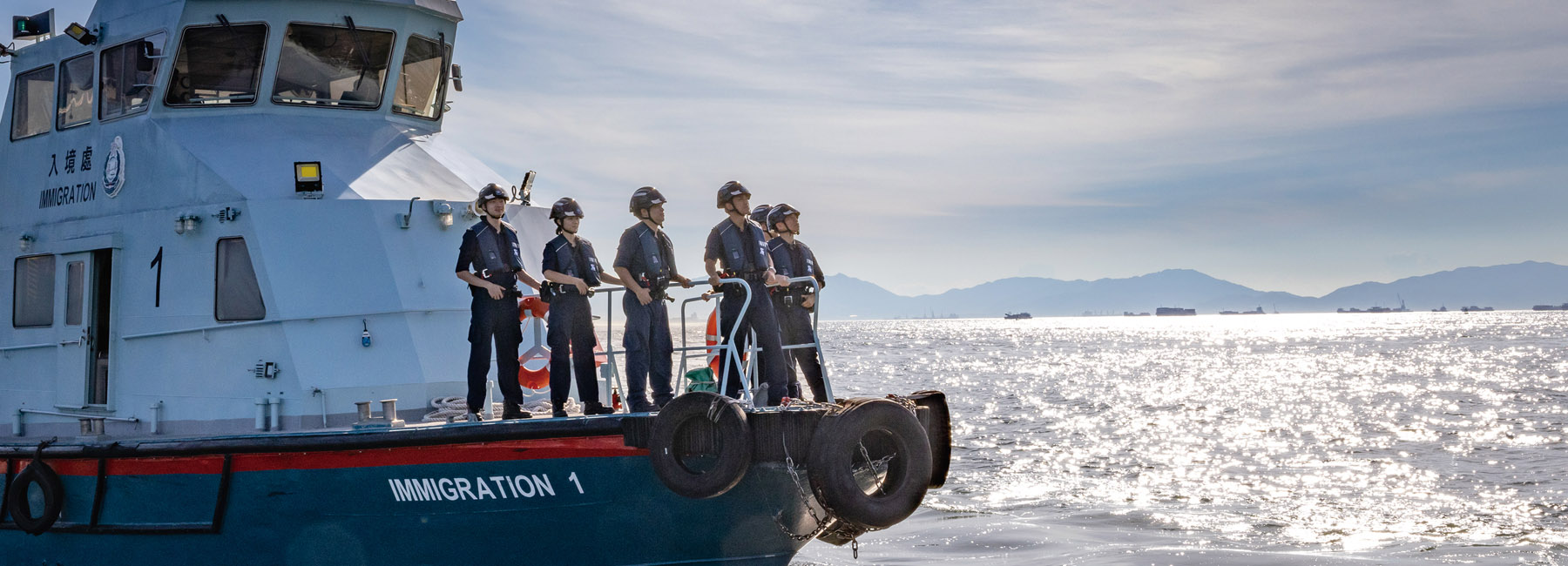



Under the command of an Assistant Director, the Control Branch comprises four divisions, namely the Airport Division, the Boundary (Rail) Division, the Boundary (Vehicles) Division and the Harbour Division. The Airport Division and the Boundary (Rail) Division are each headed by a Senior Principal Immigration Officer while the Boundary (Vehicles) Division and the Harbour Division are each headed by a Principal Immigration Officer. These four divisions share responsibilities for immigration control by denying entry of undesirable persons and preventing wanted criminals from departure, and facilitating the mobility of travellers.
Unlike some parts of the world, the Immigration Department in Hong Kong examines every person passing in and out of Hong Kong, be it by air, land or sea. Exercising effective immigration control is crucial to maintaining law and order as well as harmonious relation with different nations and regions. Through immigration examination, wanted criminals are intercepted while undesirables are denied entry into Hong Kong. Persons who do not have the right of abode or the right to land in Hong Kong must fulfil normal immigration requirements when seeking to enter Hong Kong. These include the possession of valid travel documents, sufficient means of support and re-entry facilities to their countries of domicile. Passengers who cannot fulfil these requirements or whose bona fides as genuine visitors are in doubt will be denied entry and repatriated. In 2022, a total of 2,373 passengers were refused permission to land in Hong Kong.
 |
> 12.02
million visitors had used Smart Departure e-Channels (As at 2022) |
The department is committed to providing efficient and courteous services at control points, and constantly introduces initiatives to facilitate travellers. This enables our tourists to feel at home upon arrival in Hong Kong and have a good impression that Hong Kong people are warm and nice.
The Airport Division is responsible for exercising immigration control at the Hong Kong International Airport (HKIA).
The HKIA is one of the busiest airports in the world. In 2022, passenger arrivals and departures at the HKIA totalled 4,140,000.
The Airport Division has enhanced its performance pledge to clear 98 per cent of residents and 95 per cent of visitors within 15-minute waiting time. In 2022, all residents and visitors were cleared within 15-minute waiting time at the Airport Control Point.
To prevent the entry of undesirable persons and deter illegal migration activities, the Airport Division from time to time conducts spot checks on passengers in the arrival and departure halls, transit lounge, transfer areas and boarding gates.
To provide greater convenience for departing visitors, self-service departure for visitors (Smart Departure) was launched at the HKIA on 10 October 2017. The service was extended to other control points on 18 December 2017. Smart Departure employs facial recognition technology for identity verification, which allows eligible visitors holding electronic travel documents to perform self-service departure clearance through Smart Departure e-Channels without prior enrolment.
To meet the demand for business aviation services, the Business Aviation Centre was set up at the HKIA to provide travel convenience for users of private or charter aircrafts on a user-pay basis. Business travellers benefit most from the dedicated immigration clearance services. In 2022, a total of 2,105 aircrafts and 11,773 travellers and crew members used the centre.
SkyPier, a cross-boundary passenger ferry terminal for transit passengers located at the HKIA, provides direct air-sea link between the HKIA and nine ports in the Pearl River Delta, namely Nansha and Lianhuashan of Guangzhou, Shekou and Fuyong of Shenzhen, Humen of Dongguan, Zhongshan, Jiuzhou of Zhuhai, the Macao Maritime Ferry Terminal and Taipa. Transit passengers using the SkyPier services can enjoy travel convenience at the HKIA without having to go through immigration and customs formalities. There are a total of 76 participating airlines that provide check-in services at SkyPier. In 2022, more than 120,000 arriving and 17 departing transit passengers made use of SkyPier.
To further enhance the service, cross-boundary one-stop advance check-in services are available at Nansha, Lianhuashan, Shekou, Fuyong, Humen, Zhongshan, Jiuzhou, the Macao Maritime Ferry Terminal and Taipa. Passengers can obtain their boarding passes and check in their luggage for direct transfer from ferries using SkyPier to their designated flights at the HKIA. Currently, there are 46 airlines providing the service.
Visitors aged 18 or above who hold a valid Hong Kong Special Administrative Region (HKSAR) Travel Pass or an APEC Business Travel Card with the economy code 'HKG' can enjoy self-service immigration clearance at the HKIA after enrolment with the department. The frequent visitor e-Channel service has been extended to cover selected members of Frequent Flyer Programmes of designated airlines which have joined this arrangement and visitors who (a) hold a valid travel document which does not require an entry visa/permit for entering Hong Kong; (b) have made visits to Hong Kong by air via the HKIA for not less than three times in the 12 months immediately before enrolment; and (c) have no adverse record in Hong Kong.
The department implemented arrangements for the mutual use of self-service immigration clearance with Korea, Singapore, Germany, Australia and Thailand. All eligible visitors under the arrangements may enrol for the e-Channel service at the Immigration Tower, the HKIA or the Macau Ferry Terminal Control Point.
As at 31 December 2022, over 344,000 frequent visitors had enrolled for the service at the Airport Control Point. Over 5.82 million arriving and over 9.16 million departing visitors had made use of self-service immigration clearance.
A total of 66 multi-purpose e-Channels are installed at the HKIA, with 26 at the arrival halls and 40 at the departure halls.
To provide more convenient departure clearance service for Hong Kong residents and tie in with the implementation of the Flight Token system by the Airport Authority Hong Kong (AAHK), the department launched the Flight Token e-Channel service at the HKIA on 25 October 2022.
The Flight Token is one of the smart airport initiatives developed by the AAHK. It employs facial recognition technology to enable departing passengers to have their identity verified when going through the check-in to boarding procedures at various checkpoints simply by showing their faces, without the need of checks by repetitive display of travel documents and boarding passes.
Hong Kong residents aged 11 or above, who are holders of a valid HKSAR Passport, HKSAR Document of Identity for Visa Purposes or Hong Kong and Macao Residents Entry and Exit Permit (commonly known as the 'Home Visit Permit') and choose to use the AAHK's Flight Token service when departing from Hong Kong, are eligible to use Flight Token e-Channels for self-service departure clearance. Upon entering Flight Token e-Channels, eligible Hong Kong residents may complete self-service departure clearance simply by looking at the camera and having their identity verified through facial recognition technology. There is no need to present any travel documents throughout.
A total of 8 Flight Token e-Channels are installed at the HKIA, with 4 at the south departure hall and 4 at the north departure hall.
As at 31 December 2022, over 100,000 residents had used the Flight Token e-Channel service.
The Boundary (Rail) Division comprises four control points located at Lo Wu, Hung Hom, Lok Ma Chau Spur Line and West Kowloon Station of the Guangzhou-Shenzhen-Hong Kong Express Rail Link. The Lo Wu and Lok Ma Chau Spur Line Control Points handle passengers conveyed by the MTR. The Hung Hom and Express Rail Link West Kowloon Control Points provide immigration clearance services for passengers who travel to and from the Mainland by through train and high speed rail.
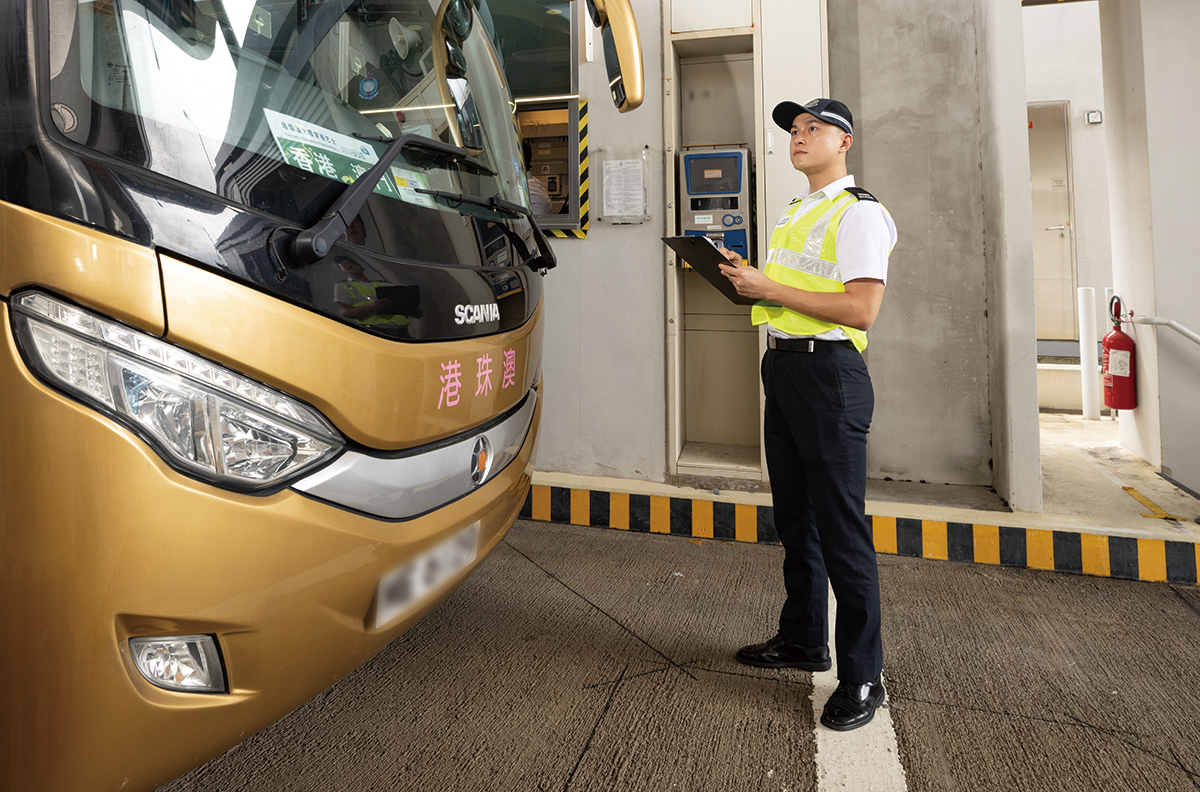
Apart from the Passenger Clearance Building, there are vehicle clearance kiosks in Hong Kong-Zhuhai-Macao Bridge Control Point, providing immigration clearance for cross-boundary vehicles.
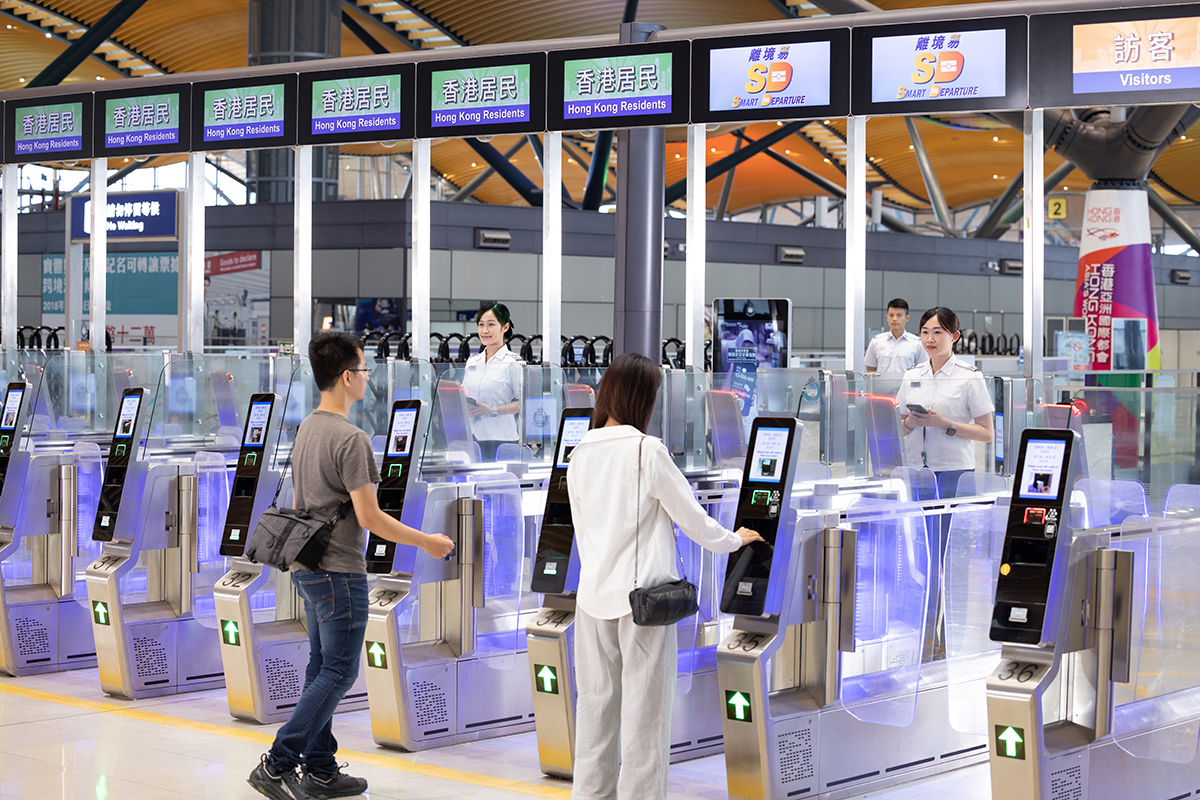
A total of 88 multi-purpose e-Channels are installed at the HZMB Control Point.
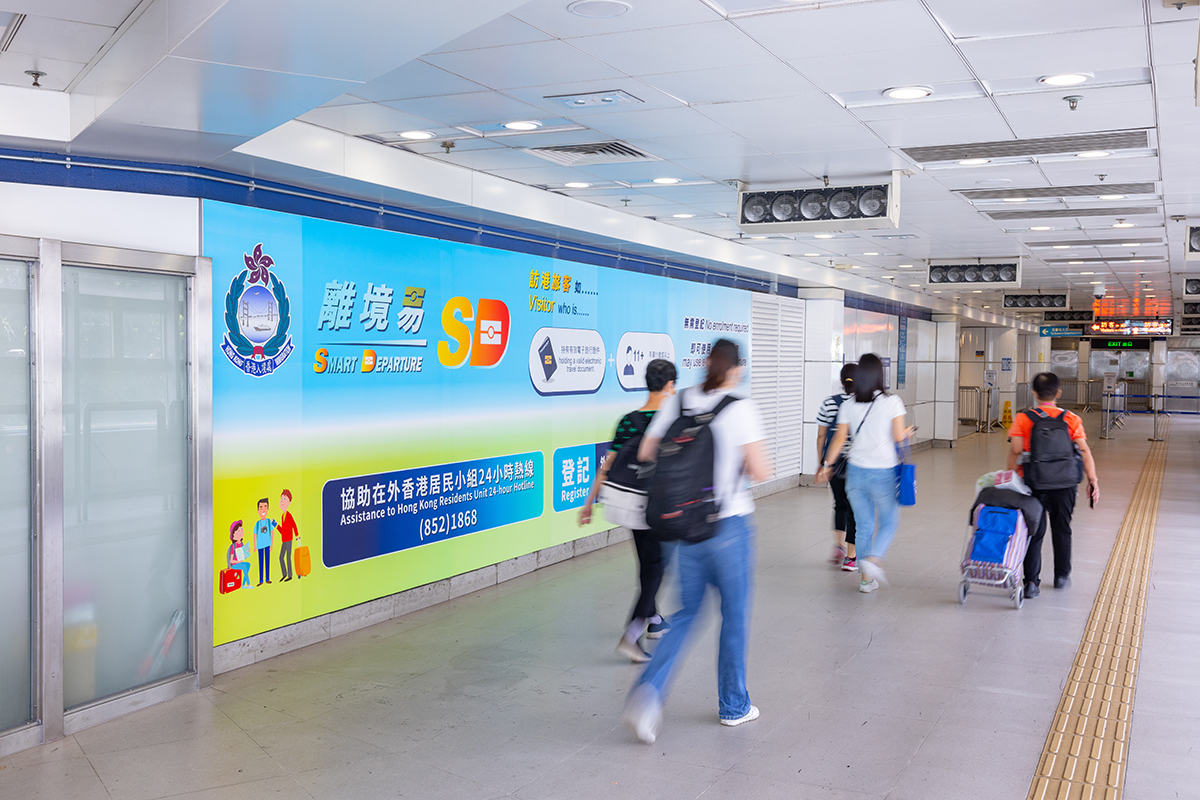
Smart Departure e-Channel employs facial recognition technology for identity verification, which allows eligible visitors holding electronic travel documents to perform self-service departure clearance through Smart Departure e-Channels without prior enrolment.
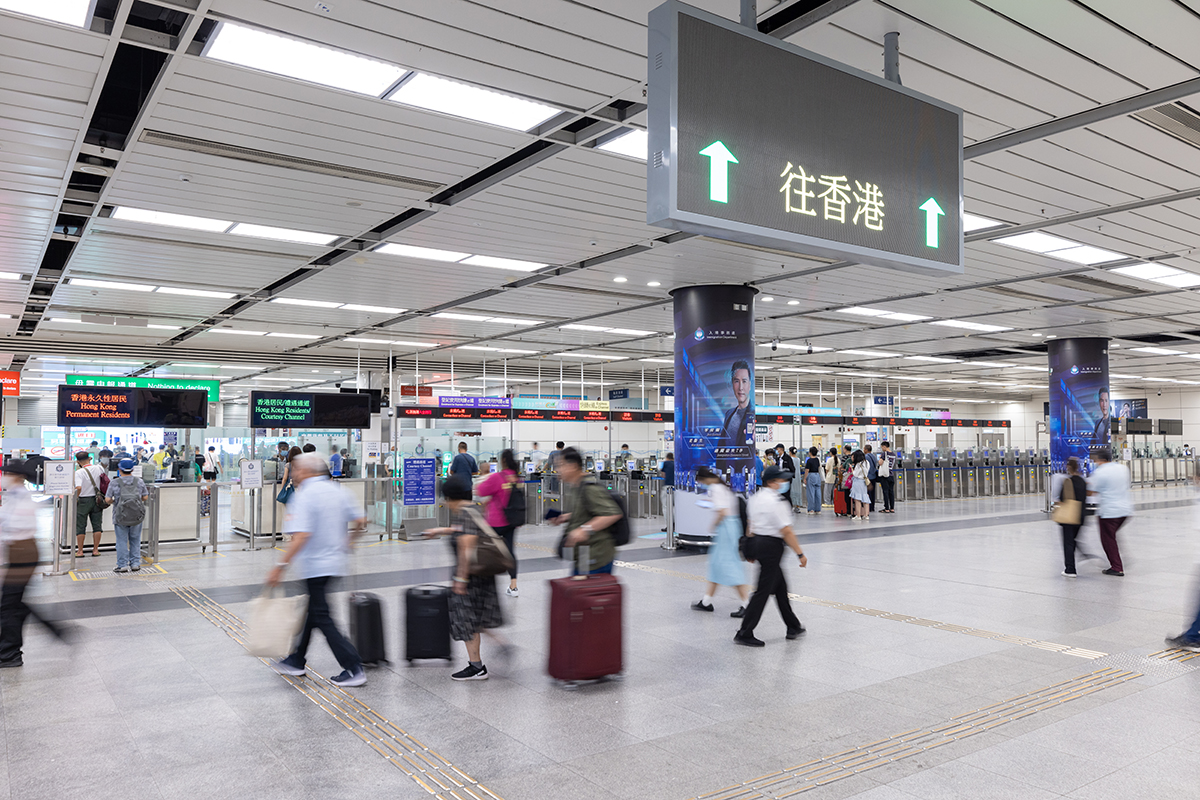
In 2022, the passenger throughput at the Shenzhen Bay Control Point was 930,000, of which 190,000 were visitors, representing a rise of 111.1 per cent as compared with that in 2021.

The department spares no efforts in guarding our country's southern gateway, keeping out undesirables from Hong Kong.
The Lo Wu Control Point was the busiest land boundary control point in Hong Kong with the highest passenger traffic. In response to the developments of the COVID-19 pandemic, the HKSAR Government has suspended the passenger clearance services at the Lo Wu Control Point since 4 February 2020.
The daily average passenger traffic at the Lo Wu Control Point before the suspension of passenger clearance services on 4 February 2020 was 160,000. During weekends or festive periods, the daily passenger figure could always exceed 200,000. To cope with the huge passenger traffic during festive periods, the department deployed extra manpower from other sections to reinforce the Lo Wu Control Point.
To expedite the immigration clearance of cross-boundary students (CBS), there is a total of 6 designated e-Channels for CBS at the Lo Wu Control Point. In addition, there is a total of 181 multi-purpose e-Channels, with 96 at the arrival hall and 85 at the departure hall.
The Hung Hom Control Point provides immigration clearance services for passengers travelling to and from the Mainland by through train. The daily 20 runs of through trains to and from the Mainland serve Guangzhou and Changping of Guangdong province, and as far as Shanghai and Beijing. In response to the developments of the COVID-19 pandemic, the HKSAR Government has suspended the passenger clearance services at the Hung Hom Control Point since 30 January 2020.
A total of 17 multi-purpose e-Channels are installed at the Hung Hom Control Point, with 9 at the arrival hall and 8 at the departure hall.
The Lok Ma Chau Spur Line Control Point, located at Lok Ma Chau Terminus of the MTR East Rail Line, is another land boundary control point for railway passengers. There is a public transport interchange adjacent to the Terminus to cater for cross-boundary passengers by franchised bus, green minibus or taxi. The control point is linked to the Futian Port of Shenzhen by a two-level passenger bridge.
In response to the developments of the COVID-19 pandemic, the HKSAR Government has suspended the passenger clearance services at the Lok Ma Chau Spur Line Control Point since 4 February 2020.
To expedite the immigration clearance of CBS, there is a total of 6 designated e-Channels for CBS at the Lok Ma Chau Spur Line Control Point. There is a total of 106 multi-purpose e-Channels, with 50 at the arrival hall and 56 at the departure hall.
The Express Rail Link West Kowloon Control Point was officially commissioned on 23 September 2018. It adopts the 'co-location' mode of clearance arrangement, which allows passengers to go through both Hong Kong and Mainland immigration clearance inside the control point.
In response to the developments of the COVID-19 pandemic, the HKSAR Government has suspended the passenger clearance services at the Express Rail Link West Kowloon Control Point since 30 January 2020.
A total of 51 multi-purpose e-Channels are installed at the Express Rail Link West Kowloon Control Point, with 22 at the arrival hall and 29 at the departure hall.
The Boundary (Vehicles) Division comprises six boundary control points located at Lok Ma Chau, Man Kam To, Sha Tau Kok, Shenzhen Bay, the Hong Kong-Zhuhai-Macao Bridge (HZMB) Hong Kong Port and Heung Yuen Wai. These control points provide immigration clearance services for cross-boundary vehicles and passengers travelling to and from the Mainland by shuttle bus (at Lok Ma Chau and the HZMB only), coach or car.
In response to the developments of the COVID-19 pandemic, the HKSAR Government has suspended the passenger clearance services at the Lok Ma Chau Control Point since 4 February 2020. In 2022, the vehicle throughput at the Lok Ma Chau Control Point was 530,000, representing a fall of 71.5 per cent as compared with that in 2021.
A total of 39 multi-purpose e-Channels are installed at the Lok Ma Chau Control Point, with 16 at the arrival hall and 23 at the departure hall.
According to the Outline Development Plan for the Guangdong-Hong Kong-Macao Greater Bay Area (GBA) promulgated by the Central Government in 2019, expediting infrastructural connectivity among GBA cities is one of the key areas of development, which will be realised by enhancing the handling capacity and clearance facilitation of control points in Guangdong, Hong Kong and Macao and promoting an efficient and convenient flow of people and goods. The governments of Hong Kong and Shenzhen have been making concerted efforts to take forward the redevelopment of the Huanggang Port/Lok Ma Chau Control Point, with a view to enhancing the clearance facilities and strengthening the passenger handling capacity. The 'co-location' arrangement will be implemented at the redeveloped Huanggang Port and the introduction of a new and convenient mode of 'collaborative inspection and joint clearance' will also be considered. The department will continue to support the overall development and proactively carry out all relevant preparation work.
The Man Kam To Control Point provides immigration clearance services for cross-boundary vehicles and passengers. In response to the developments of the COVID-19 pandemic, the HKSAR Government has suspended the passenger clearance services at the Man Kam To Control Point since 30 January 2020. In 2022, the vehicle throughput at the Man Kam To Control Point was 580,000, representing a fall of 28.4 per cent as compared with that in 2021.
A total of 18 multi-purpose e-Channels are installed at the Man Kam To Control Point, with 9 at the arrival hall and 9 at the departure hall.
The Sha Tau Kok Control Point provides immigration clearance services for cross-boundary vehicles and passengers. Passengers mainly travel between the Mainland and Hong Kong by coach, hire car or private car. In response to the developments of the COVID-19 pandemic, the HKSAR Government has suspended the passenger clearance services at the Sha Tau Kok Control Point since 30 January 2020. In 2022, the vehicle throughput at the Sha Tau Kok Control Point was 30,000, representing a fall of 88 per cent as compared with that in 2021.
A total of 10 multi-purpose e-Channels are installed at the Sha Tau Kok Control Point, with 5 at the arrival hall and 5 at the departure hall.
The Shenzhen Bay Control Point, the first boundary control point adopting the 'co-location' mode of clearance arrangement, provides immigration clearance services for both passengers and vehicles travelling between the Mainland and Hong Kong.
Under this arrangement, much time is saved as passengers conveyed by coach only have to get on and off the vehicles once instead of twice when going through immigration clearance at both the immigration authorities within the Passenger Terminal Building. For each vehicular clearance kiosk, staff of both the Immigration Department and the Customs and Excise Department are housed in two closely adjoining compartments, facilitating the provision of one-stop immigration and customs clearance services to cross-boundary vehicles.
In response to the developments of the COVID-19 pandemic, the HKSAR Government has adjusted the operating hours of the passenger clearance services at the Shenzhen Bay Control Point several times. With effect from 8 July 2022, the operating hours of the Passenger Clearance Building and passenger clearance services for private cars are from 09:00 a.m. to 08:00 p.m. daily.
As announced in 2019 Policy Address, the operating hours of the Shenzhen Bay Port would be extended to 24 hours in order to cater for the needs of cross-boundary passengers. To further support the logistics flow between Shenzhen and Hong Kong to cope with the cross-boundary goods traffic in the early hours, and to tie in with the 'East in East out, West in West out' planning strategy, the governments of Shenzhen and Hong Kong decided after discussions to extend the operating hours of cargo clearance to 24 hours at the Shenzhen Bay Control Point with effect from 10 December 2020. In view of the COVID-19 pandemic, both governments will consider when to provide round-the-clock passenger clearance services at the Shenzhen Bay Control Point taking into account the pandemic developments of the two places.
In 2022, the passenger throughput at the Shenzhen Bay Control Point rose by 10.7 per cent from 840,000 in 2021 to 930,000, of which 190,000 were visitors, representing a rise of 111.1 per cent as compared with that in 2021.
The vehicle throughput at the Shenzhen Bay Control Point was 1.16 million in 2022, representing a fall of 54.2 per cent as compared with 2.53 million in 2021. Among these vehicles, 0.2 per cent were private cars, 99.7 per cent were goods vehicles and the rest were coaches.
A total of 63 multi-purpose e-Channels are installed at the Shenzhen Bay Control Point, with 24 at the arrival hall and 39 at the departure hall.
The HZMB Control Point was officially commissioned on 24 October 2018. It is the first land-boundary control point linking Hong Kong, Zhuhai and Macao. The boundary crossing facilities of the HZMB adopt the 'separate locations' mode of clearance arrangement. The governments of the three places have set up their own boundary crossing facilities within their respective boundaries. Facilities such as the Passenger Clearance Building and vehicle clearance kiosks at the Hong Kong Port provide immigration clearance services for cross-boundary passengers and vehicles respectively.
In response to the developments of the COVID-19 pandemic, the HKSAR Government has adjusted the operating hours of the passenger clearance services at the HZMB Control Point with effect from 5 April 2020 until further notice. The operating hours of the Passenger Clearance Building (i.e. for cross-border travelling by cross-boundary coach and shuttle bus) are from 10:00 a.m. to 8:00 p.m. daily. The operating hours of the passenger clearance service for private cars are from 6:00 a.m. to 10:00 p.m. daily while those for cargo clearance remain as 24 hours daily.
In 2022, the passenger throughput at the HZMB Control Point rose by 58.3 per cent from 120,000 in 2021 to 190,000, of which 60,000 were visitors, representing a rise of 500 per cent as compared with that in 2021.
The vehicle throughput at the HZMB Control Point was 220,000 in 2022, representing a rise of 37.5 per cent as compared with 160,000 in 2021. Among these vehicles, 1 per cent were private cars, 94.7 per cent were goods vehicles, 4.2 per cent were shuttle buses and the rest were coaches.
A total of 88 multi-purpose e-Channels are installed at the HZMB Control Point, with the arrival hall and the departure hall each installed with 44 such e-Channels.
The Heung Yuen Wai Boundary Control Point, which is the seventh land-based control point at the Hong Kong-Shenzhen boundary and located between the Man Kam To and Sha Tau Kok Control Points, is a boundary control point that offers 'direct access by passengers and vehicles'.
There are 14 multi-purpose e-Channels and 9 conventional counters on each of the arrival and departure levels of the Passenger Terminal Building at the Heung Yuen Wai Boundary Control Point, providing immigration clearance services for passengers. Both the inbound and outbound routes on the podium of the first floor of the Passenger Terminal Building are installed with four clearance kiosks for private cars and two clearance kiosks for coaches. Moreover, nine goods vehicle clearance kiosks are installed on the inbound and outbound clearance routes respectively for cross-boundary drivers.
In view of the COVID-19 pandemic, the governments of Guangdong and Hong Kong had agreed to first open the cargo clearance facilities for cross-boundary goods vehicles on 26 August 2020, while passenger clearance service would be provided in due course subject to the developments of the pandemic.
The goods vehicle throughput at the Heung Yuen Wai Boundary Control Point was 310,000 in 2022, representing a fall of 39.2 per cent as compared with 510,000 in 2021.
To further facilitate CBS travelling between the Mainland and Hong Kong, the department adopted the simplified clearance procedure for CBS at the Lok Ma Chau Spur Line, Shenzhen Bay, Lok Ma Chau, Man Kam To, Sha Tau Kok and Lo Wu Control Points. The service was provided with the use of information technology and a portable device to simplify the immigration clearance process for CBS. In addition, the on-board clearance service now available at the Man Kam To, Sha Tau Kok and Lok Ma Chau Control Points has been further extended to the HZMB Control Point since 2019 to provide speedier and safer clearance services for CBS. In view of the pandemic developments, the HKSAR Government will discuss with the Mainland authorities the feasibility of the return of CBS to Hong Kong for class resumption in a timely manner.
The Harbour Division is responsible for providing immigration clearance services for people travelling through the ports of Hong Kong. There are five sections under the command of the Harbour Division, namely the Harbour Control Section, the Macau Terminal Section, the China Ferry Terminal Section, the River Trade Terminal Section and the Kai Tak Cruise Terminal Section.
One of the duties of the Harbour Control Section is to conduct immigration clearance on incoming and outgoing vessels at the two designated immigration anchorages, namely the Eastern Quarantine and Immigration Anchorage and the Western Quarantine and Immigration Anchorage. In 2022, the Harbour Control Section cleared a total of 123,693 vessels, representing an increase of about 0.2 per cent as compared with 123,395 vessels in 2021.
Besides, the Harbour Control Section is responsible for handling cases concerning the repatriation and emergency discharge of seamen, deserters, stowaways, etc. To step up post-entry examination, the Ship Searching Unit of the Section conducts searches and spot checks on vessels in Hong Kong waters regularly to ensure that all incoming vessels comply with immigration requirements.
The Ship Searching Unit expanded from four operation teams and one intelligence and logistics support team to eight operation teams and one intelligence and logistics support team. The operation teams are responsible for conducting searches and spot checks on vessels in Hong Kong waters to detect cases of evasion of immigration examination, forgery, illegal immigration, overstaying, etc., with a view to strengthening immigration control at sea and combating illicit immigration activities. The intelligence and logistics support team is responsible for the collection and analysis of relevant information and intelligence.
To facilitate business of the cargo and logistics industry, the Pre-arrival Clearance Scheme has been implemented for years. Under the scheme, pre-approved vessels can proceed directly to berths or terminals for cargo operations without having to wait for immigration clearance at immigration anchorages. In 2022, a total of 16,856 ocean-going vessels and 40,532 Mainland river/coastal trade vessels were approved under this Scheme prior to their entry to Hong Kong.
The arrangement helps save much of the operational costs and time. It also helps strengthen and enhance Hong Kong's position as a preferred international and regional transportation and logistics hub.
The Macau Terminal Section provides immigration clearance services for passengers travelling by vessel between Hong Kong and Macao or nearby ports of Guangdong Province, or by helicopter between Hong Kong and Macao at the Macau Ferry Terminal. In response to the developments of the COVID-19 pandemic, the HKSAR Government has suspended the passenger clearance services at the Macau Ferry Terminal since 4 February 2020.
The Macau Ferry Terminal was the busiest immigration check point among all harbour control points. The majority of the passengers were Hong Kong residents. Before the suspension of passenger clearance services, the terminal operated round-the-clock with around 180 daily sailings between Hong Kong and Macao or the Mainland. There was also helicopter service between Hong Kong and Macao, with around 16 flights per day.
A total of 54 multi-purpose e-Channels are installed at the Macau Ferry Terminal Control Point, with 26 at the arrival hall and 28 at the departure hall.
The China Ferry Terminal Section provides immigration clearance services for passengers travelling by vessel between Hong Kong and the Mainland or Macao at the China Ferry Terminal. In response to the developments of the COVID-19 pandemic, the HKSAR Government has suspended the passenger clearance services at the China Ferry Terminal since 30 January 2020.
Before the suspension of passenger clearance services, the China Ferry Terminal handled a daily average of 79 sailings between Hong Kong and Macao or the Mainland.
A total of 28 multi-purpose e-Channels are installed at the China Ferry Terminal Control Point, with 11 at the arrival hall and 17 at the departure hall.
The River Trade Terminal Section provides round-the-clock immigration clearance services for Mainland river and coastal trade vessels at the Tuen Mun Immigration Anchorage so as to relieve the heavy traffic at Ma Wan Channel and facilitate trade activities. In 2022, a daily average of 32 river vessels were cleared at the Tuen Mun Immigration Anchorage. The River Trade Terminal Section also deals with the repatriation and emergency discharge of seamen, deserters, stowaways, etc.
The Kai Tak Cruise Terminal Section provides immigration clearance services for passengers and crew members of cruise liners berthing at the Kai Tak Cruise Terminal, the Ocean Terminal and other anchorages, as well as Hong Kong-based passenger liners. In response to the developments of the COVID-19 pandemic, the HKSAR Government suspended the passenger clearance services at the Kai Tak Cruise Terminal from the afternoon of 5 February 2020 to 29 July 2021. Subsequently, between 30 July 2021 and 6 January 2022, cruise lines were allowed to resume for Hong Kong residents 'cruise-to-nowhere' itineraries which did not involve ports outside Hong Kong. Such itineraries were once suspended from 7 January 2022 and resumed later from 19 May 2022.
In 2022, a total of 52 sailings of overseas and Hong Kong-based passenger liners with around 10,000 passengers were handled by the Kai Tak Cruise Terminal Section. Moreover, the terminal is installed with 7 multi-purpose e-Channels in total.